NISSAN TEANA 2008 Service Manual
Manufacturer: NISSAN, Model Year: 2008, Model line: TEANA, Model: NISSAN TEANA 2008Pages: 5121, PDF Size: 69.03 MB
Page 901 of 5121
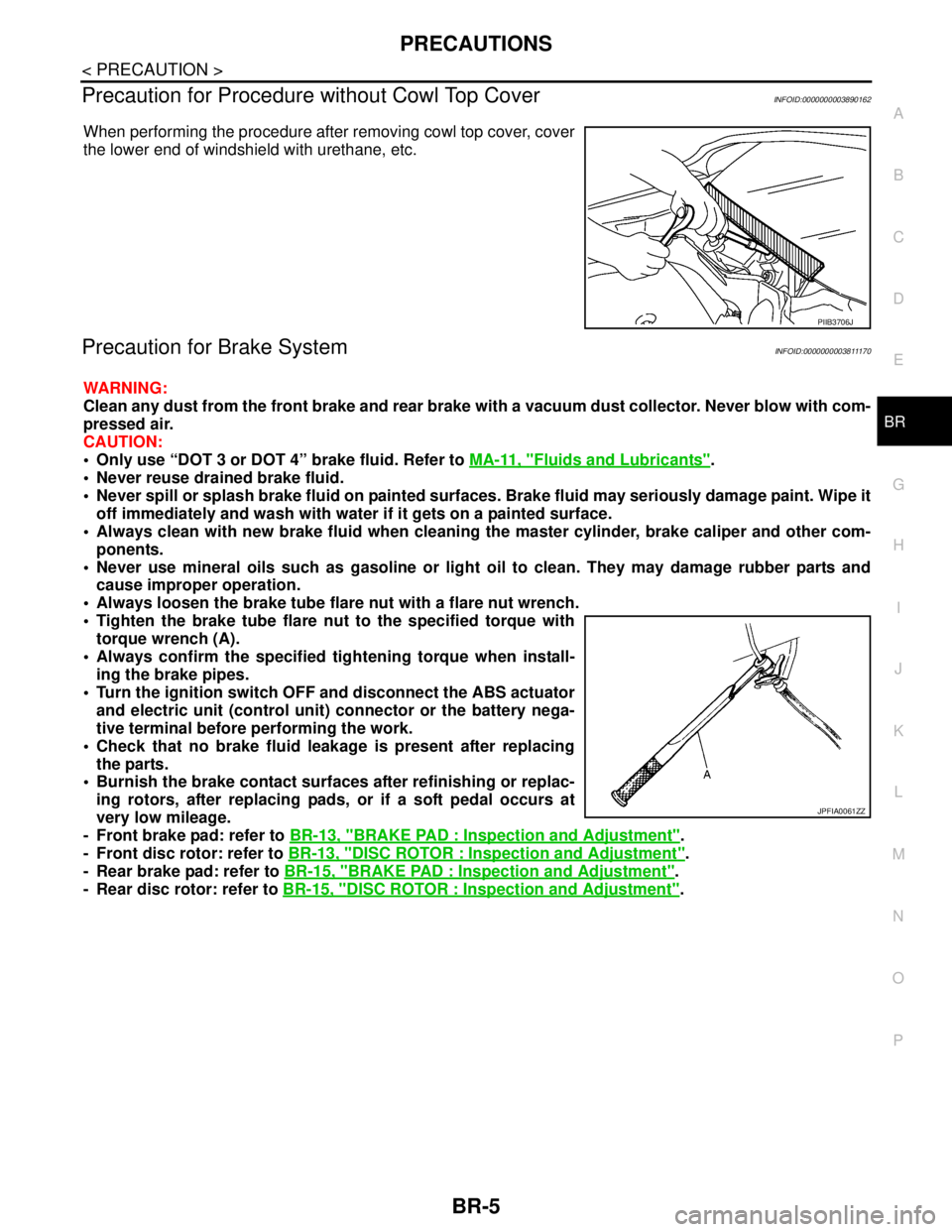
PRECAUTIONS
BR-5
< PRECAUTION >
C
D
E
G
H
I
J
K
L
MA
B
BR
N
O
P
Precaution for Procedure without Cowl Top CoverINFOID:0000000003890162
When performing the procedure after removing cowl top cover, cover
the lower end of windshield with urethane, etc.
Precaution for Brake SystemINFOID:0000000003811170
WARNING:
Clean any dust from the front brake and rear brake with a vacuum dust collector. Never blow with com-
pressed air.
CAUTION:
Only use “DOT 3 or DOT 4” brake fluid. Refer to MA-11, "
Fluids and Lubricants".
Never reuse drained brake fluid.
Never spill or splash brake fluid on painted surfaces. Brake fluid may seriously damage paint. Wipe it
off immediately and wash with water if it gets on a painted surface.
Always clean with new brake fluid when cleaning the master cylinder, brake caliper and other com-
ponents.
Never use mineral oils such as gasoline or light oil to clean. They may damage rubber parts and
cause improper operation.
Always loosen the brake tube flare nut with a flare nut wrench.
Tighten the brake tube flare nut to the specified torque with
torque wrench (A).
Always confirm the specified tightening torque when install-
ing the brake pipes.
Turn the ignition switch OFF and disconnect the ABS actuator
and electric unit (control unit) connector or the battery nega-
tive terminal before performing the work.
Check that no brake fluid leakage is present after replacing
the parts.
Burnish the brake contact surfaces after refinishing or replac-
ing rotors, after replacing pads, or if a soft pedal occurs at
very low mileage.
- Front brake pad: refer to BR-13, "
BRAKE PAD : Inspection and Adjustment".
- Front disc rotor: refer to BR-13, "
DISC ROTOR : Inspection and Adjustment".
- Rear brake pad: refer to BR-15, "
BRAKE PAD : Inspection and Adjustment".
- Rear disc rotor: refer to BR-15, "
DISC ROTOR : Inspection and Adjustment".
PIIB3706J
JPFIA0061ZZ
Page 902 of 5121

BR-6
< ON-VEHICLE MAINTENANCE >
BRAKE PEDAL
ON-VEHICLE MAINTENANCE
BRAKE PEDAL
Inspection and AdjustmentINFOID:0000000003811172
INSPECTION
Brake Pedal Height
Check the brake pedal height (H1) between the dash lower panel (1)
and the brake pedal upper surface.
CAUTION:
Remove the floor trim.
Stop Lamp Switch and ASCD Brake Switch
Check the clearance (C) between stopper rubber (1) and stop lamp
switch and ASCD brake switch (2) threaded end.
CAUTION:
The stop lamp must be turned off when the brake pedal is
released.
NOTE:
Pull the brake pedal pad to make the clearance between stopper
rubber and stop lamp switch and ASCD brake switch threaded end.
Brake Pedal Play
Press the brake pedal. Check the brake pedal play (A).
Depressed Brake Pedal Height
Check the brake pedal height (H2) between the dash lower panel (1)
and the brake pedal upper surface when depressing the brake pedal
at 490 N (50 kg, 110 lb) while turning engine ON.
CAUTION:
Remove the floor trim.Standard
H
1: Refer to BR-45, "Brake
Pedal".
JPFIA0065ZZ
Standard
C : Refer to BR-45, "
Brake
Pedal".
JPFIA0122ZZ
Standard
A : Refer to BR-45, "
Brake
Pedal".
JPFIA0121ZZ
Standard
H
2: Refer to BR-45, "Brake
Pedal".
JPFIA0068ZZ
Page 903 of 5121
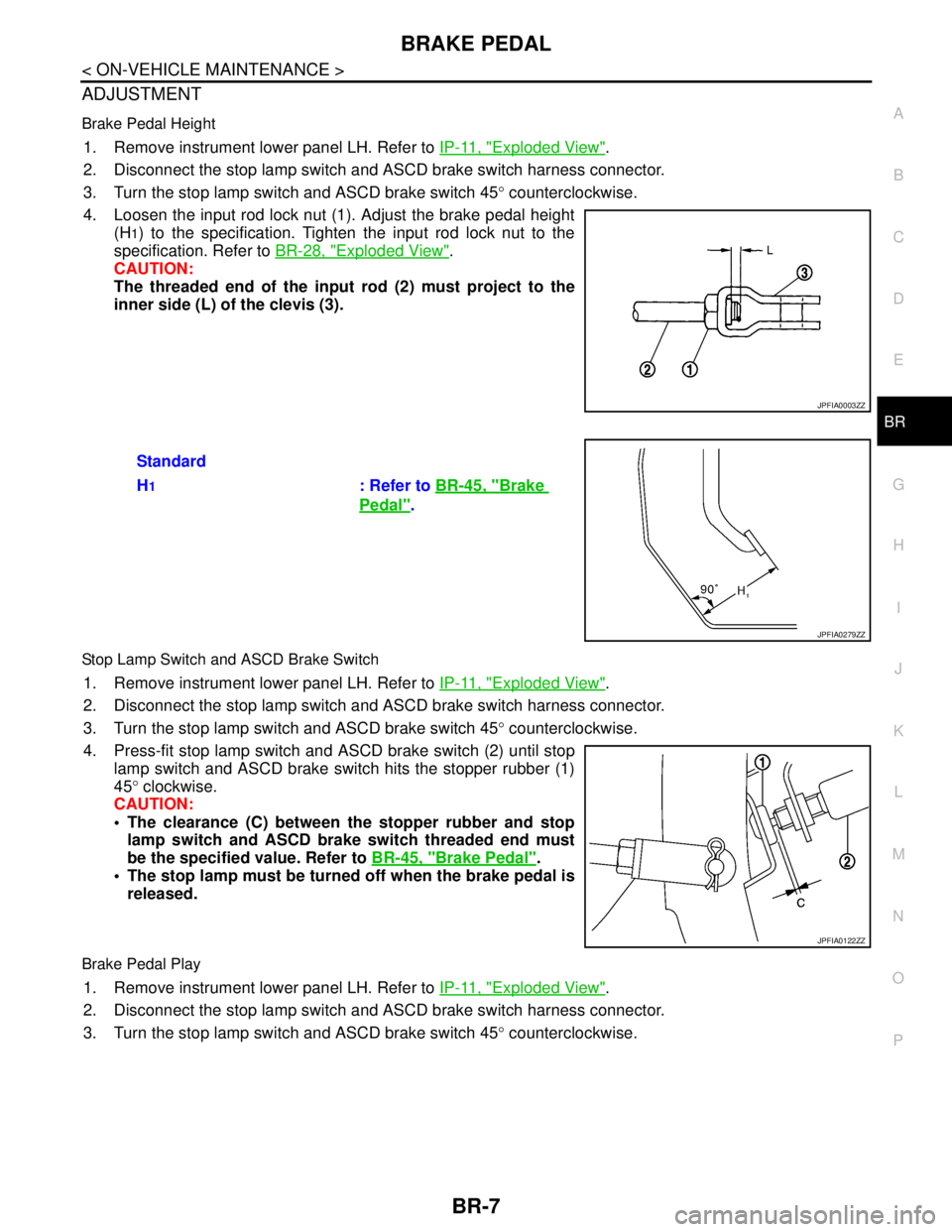
BRAKE PEDAL
BR-7
< ON-VEHICLE MAINTENANCE >
C
D
E
G
H
I
J
K
L
MA
B
BR
N
O
P
ADJUSTMENT
Brake Pedal Height
1. Remove instrument lower panel LH. Refer to IP-11, "Exploded View".
2. Disconnect the stop lamp switch and ASCD brake switch harness connector.
3. Turn the stop lamp switch and ASCD brake switch 45° counterclockwise.
4. Loosen the input rod lock nut (1). Adjust the brake pedal height
(H
1) to the specification. Tighten the input rod lock nut to the
specification. Refer to BR-28, "
Exploded View".
CAUTION:
The threaded end of the input rod (2) must project to the
inner side (L) of the clevis (3).
Stop Lamp Switch and ASCD Brake Switch
1. Remove instrument lower panel LH. Refer to IP-11, "Exploded View".
2. Disconnect the stop lamp switch and ASCD brake switch harness connector.
3. Turn the stop lamp switch and ASCD brake switch 45° counterclockwise.
4. Press-fit stop lamp switch and ASCD brake switch (2) until stop
lamp switch and ASCD brake switch hits the stopper rubber (1)
45° clockwise.
CAUTION:
The clearance (C) between the stopper rubber and stop
lamp switch and ASCD brake switch threaded end must
be the specified value. Refer to BR-45, "
Brake Pedal".
The stop lamp must be turned off when the brake pedal is
released.
Brake Pedal Play
1. Remove instrument lower panel LH. Refer to IP-11, "Exploded View".
2. Disconnect the stop lamp switch and ASCD brake switch harness connector.
3. Turn the stop lamp switch and ASCD brake switch 45° counterclockwise.
JPFIA0003ZZ
Standard
H
1: Refer to BR-45, "Brake
Pedal".
JPFIA0279ZZ
JPFIA0122ZZ
Page 904 of 5121
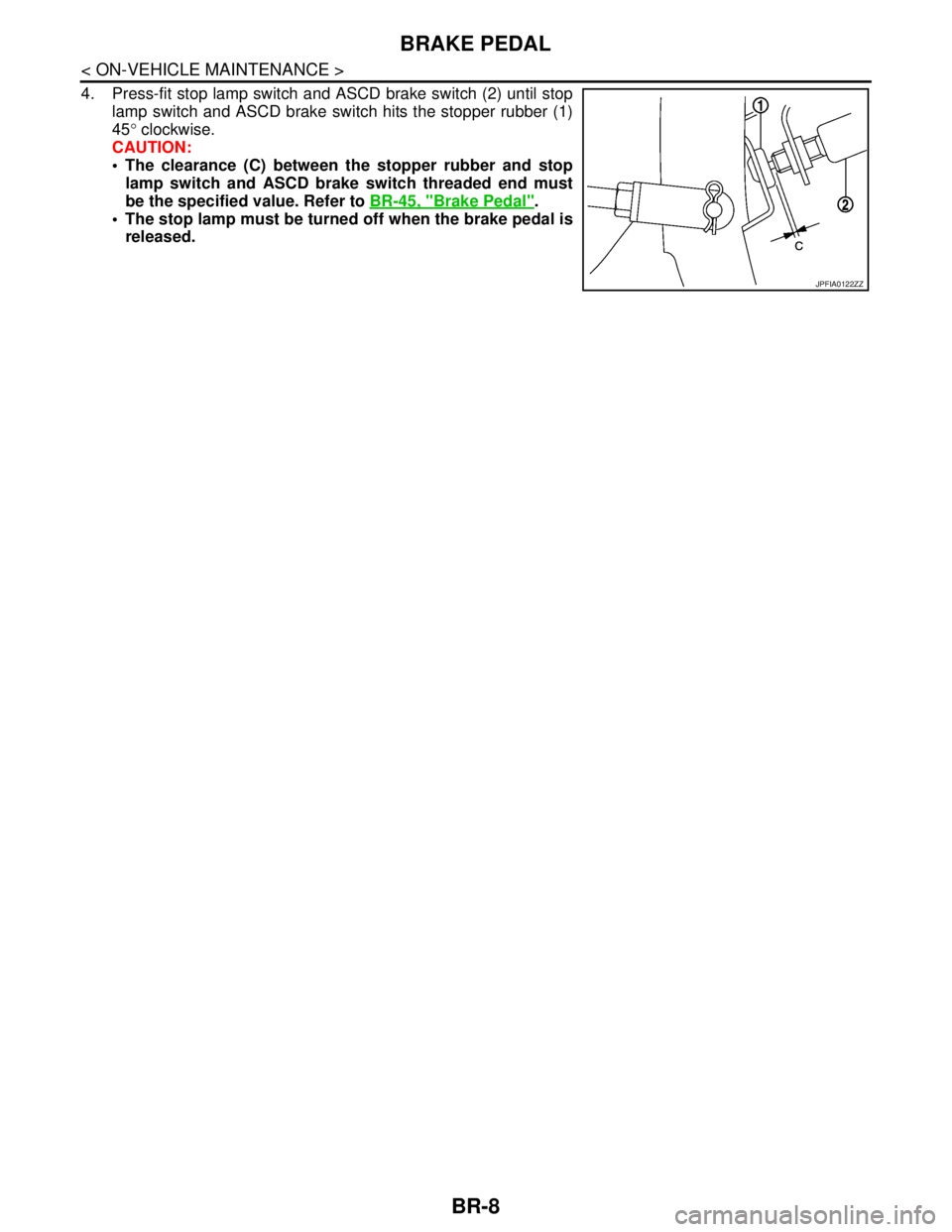
BR-8
< ON-VEHICLE MAINTENANCE >
BRAKE PEDAL
4. Press-fit stop lamp switch and ASCD brake switch (2) until stop
lamp switch and ASCD brake switch hits the stopper rubber (1)
45° clockwise.
CAUTION:
The clearance (C) between the stopper rubber and stop
lamp switch and ASCD brake switch threaded end must
be the specified value. Refer to BR-45, "
Brake Pedal".
The stop lamp must be turned off when the brake pedal is
released.
JPFIA0122ZZ
Page 905 of 5121

BRAKE FLUID
BR-9
< ON-VEHICLE MAINTENANCE >
C
D
E
G
H
I
J
K
L
MA
B
BR
N
O
P
BRAKE FLUID
InspectionINFOID:0000000003811173
BRAKE FLUID LEVEL
Check that the fluid level in the sub tank is within the specified
range (MAX – MIN lines).
Visually check for any brake fluid leakage around the sub tank,
reservoir tank and hose.
Check the brake system for any leakage if the fluid level is
extremely low (lower than MIN).
Check the brake system for fluid leakage if the warning lamp
remains illuminated even after the parking brake is released.
BRAKE LINE
1. Check brake line (tubes and hoses) for cracks, deterioration or other damage. Replace any damaged
parts.
2. Check for fluid leakage by fully depressing brake pedal while
engine is running.
CAUTION:
If leakage occurs around joints, retighten or, if necessary,
replace damaged parts.
DrainingINFOID:0000000003811174
CAUTION:
Never spill or splash brake fluid on painted surfaces. Brake fluid may seriously damage paint. Wipe it
off immediately and wash with water if it gets on a painted surface.
Turn the ignition switch OFF and disconnect the ABS actuator and electric unit (control unit) con-
nector or the battery negative terminal before draining.
1. Connect a vinyl tube to the bleed valve.
2. Depress the brake pedal and loosen the bleeder valve to gradu-
ally discharge brake fluid.
RefillingINFOID:0000000003811175
CAUTION:
Turn the ignition switch OFF and disconnect the ABS actuator and electric unit (control unit) connec-
tor or the battery negative terminal before refilling.
1. Check that there is no foreign material in the sub tank, and refill with new brake fluid.
CAUTION:
Never reuse drained brake fluid.
JPFIA0007ZZ
SBR389C
BRA0007D
Page 906 of 5121
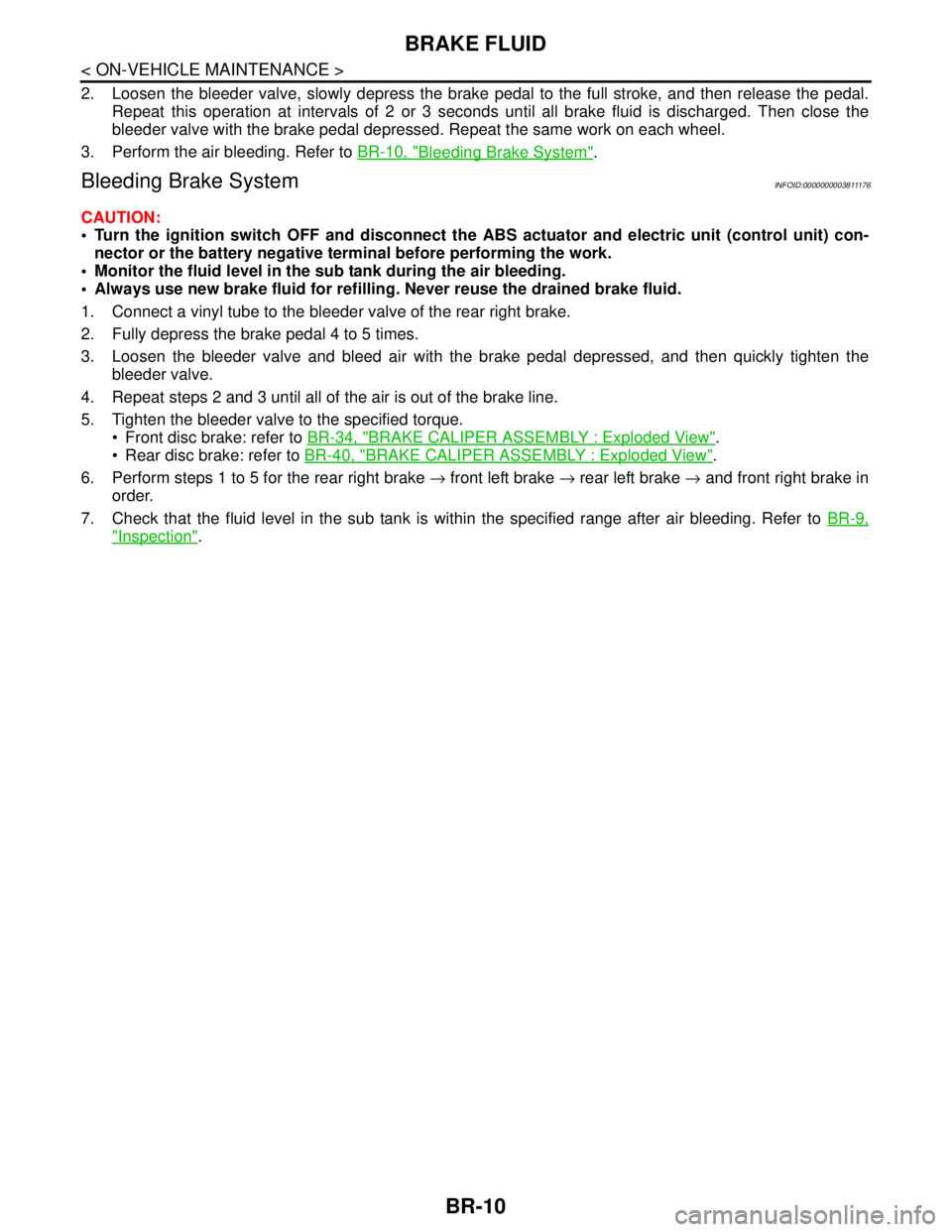
BR-10
< ON-VEHICLE MAINTENANCE >
BRAKE FLUID
2. Loosen the bleeder valve, slowly depress the brake pedal to the full stroke, and then release the pedal.
Repeat this operation at intervals of 2 or 3 seconds until all brake fluid is discharged. Then close the
bleeder valve with the brake pedal depressed. Repeat the same work on each wheel.
3. Perform the air bleeding. Refer to BR-10, "
Bleeding Brake System".
Bleeding Brake SystemINFOID:0000000003811176
CAUTION:
Turn the ignition switch OFF and disconnect the ABS actuator and electric unit (control unit) con-
nector or the battery negative terminal before performing the work.
Monitor the fluid level in the sub tank during the air bleeding.
Always use new brake fluid for refilling. Never reuse the drained brake fluid.
1. Connect a vinyl tube to the bleeder valve of the rear right brake.
2. Fully depress the brake pedal 4 to 5 times.
3. Loosen the bleeder valve and bleed air with the brake pedal depressed, and then quickly tighten the
bleeder valve.
4. Repeat steps 2 and 3 until all of the air is out of the brake line.
5. Tighten the bleeder valve to the specified torque.
Front disc brake: refer to BR-34, "
BRAKE CALIPER ASSEMBLY : Exploded View".
Rear disc brake: refer to BR-40, "
BRAKE CALIPER ASSEMBLY : Exploded View".
6. Perform steps 1 to 5 for the rear right brake → front left brake → rear left brake → and front right brake in
order.
7. Check that the fluid level in the sub tank is within the specified range after air bleeding. Refer to BR-9,
"Inspection".
Page 907 of 5121

BRAKE MASTER CYLINDER
BR-11
< ON-VEHICLE MAINTENANCE >
C
D
E
G
H
I
J
K
L
MA
B
BR
N
O
P
BRAKE MASTER CYLINDER
InspectionINFOID:0000000003811177
FLUID LEAK
Check for brake fluid leakage from the master cylinder mounting face, reservoir tank mounting face, and brake
tube connections.
Page 908 of 5121

BR-12
< ON-VEHICLE MAINTENANCE >
BRAKE BOOSTER
BRAKE BOOSTER
InspectionINFOID:0000000003811178
OPERATION
Depress the brake pedal several times at 5-second intervals with the
engine stopped. Start the engine with the brake pedal fully
depressed. Check that the clearance between brake pedal and dash
lower panel decreases.
NOTE:
A slight impact with a small click may be felt on the pedal when the
brake pedal is fully depressed. This is a normal phenomenon due to
the brake system operation.
AIR TIGHT
Idle the engine for 1 minute to apply vacuum to the brake booster,
and stop the engine. Then depress the brake pedal several times
at 5-second intervals until the accumulated vacuum is released to
atmospheric pressure. Check that the clearance between brake
pedal and dash lower panel gradually increases (A → B → C) each
time the brake pedal is depressed during this operation.
Depress the brake pedal with the engine running. Then stop the
engine while holding down the brake pedal. Check that the brake
pedal stroke does not change after holding down the brake pedal
for 30 seconds or more.
NOTE:
A slight impact with a small click may be felt on the pedal when the
brake pedal is fully depressed. This is a normal phenomenon due
to the brake system operation.
BRA0037D
JPFIA0043ZZ
JPFIA0044ZZ
Page 909 of 5121
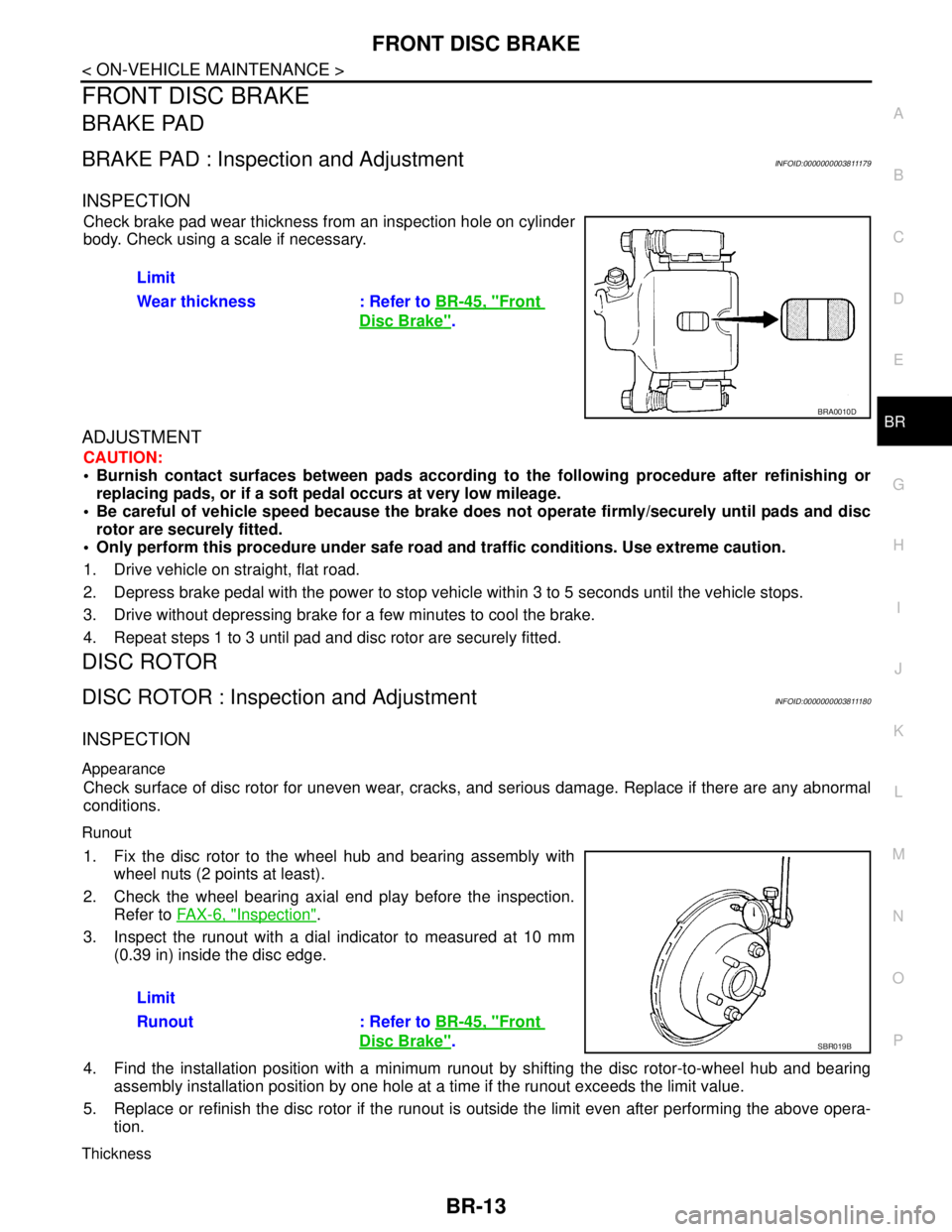
FRONT DISC BRAKE
BR-13
< ON-VEHICLE MAINTENANCE >
C
D
E
G
H
I
J
K
L
MA
B
BR
N
O
P
FRONT DISC BRAKE
BRAKE PAD
BRAKE PAD : Inspection and AdjustmentINFOID:0000000003811179
INSPECTION
Check brake pad wear thickness from an inspection hole on cylinder
body. Check using a scale if necessary.
ADJUSTMENT
CAUTION:
Burnish contact surfaces between pads according to the following procedure after refinishing or
replacing pads, or if a soft pedal occurs at very low mileage.
Be careful of vehicle speed because the brake does not operate firmly/securely until pads and disc
rotor are securely fitted.
Only perform this procedure under safe road and traffic conditions. Use extreme caution.
1. Drive vehicle on straight, flat road.
2. Depress brake pedal with the power to stop vehicle within 3 to 5 seconds until the vehicle stops.
3. Drive without depressing brake for a few minutes to cool the brake.
4. Repeat steps 1 to 3 until pad and disc rotor are securely fitted.
DISC ROTOR
DISC ROTOR : Inspection and AdjustmentINFOID:0000000003811180
INSPECTION
Appearance
Check surface of disc rotor for uneven wear, cracks, and serious damage. Replace if there are any abnormal
conditions.
Runout
1. Fix the disc rotor to the wheel hub and bearing assembly with
wheel nuts (2 points at least).
2. Check the wheel bearing axial end play before the inspection.
Refer to FA X - 6 , "
Inspection".
3. Inspect the runout with a dial indicator to measured at 10 mm
(0.39 in) inside the disc edge.
4. Find the installation position with a minimum runout by shifting the disc rotor-to-wheel hub and bearing
assembly installation position by one hole at a time if the runout exceeds the limit value.
5. Replace or refinish the disc rotor if the runout is outside the limit even after performing the above opera-
tion.
Thickness
Limit
Wear thickness : Refer to BR-45, "
Front
Disc Brake".
BRA0010D
Limit
Runout : Refer to BR-45, "
Front
Disc Brake".SBR019B
Page 910 of 5121
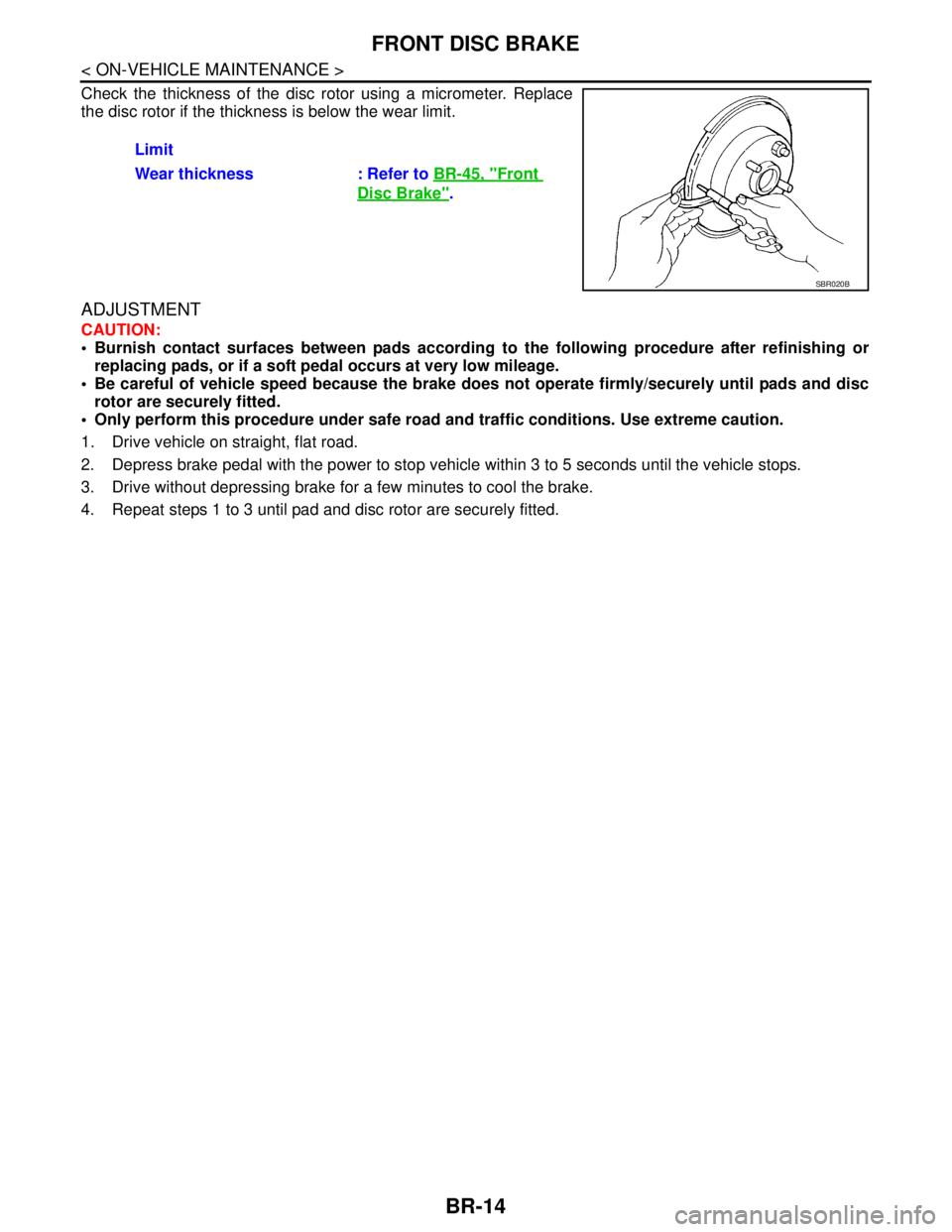
BR-14
< ON-VEHICLE MAINTENANCE >
FRONT DISC BRAKE
Check the thickness of the disc rotor using a micrometer. Replace
the disc rotor if the thickness is below the wear limit.
ADJUSTMENT
CAUTION:
Burnish contact surfaces between pads according to the following procedure after refinishing or
replacing pads, or if a soft pedal occurs at very low mileage.
Be careful of vehicle speed because the brake does not operate firmly/securely until pads and disc
rotor are securely fitted.
Only perform this procedure under safe road and traffic conditions. Use extreme caution.
1. Drive vehicle on straight, flat road.
2. Depress brake pedal with the power to stop vehicle within 3 to 5 seconds until the vehicle stops.
3. Drive without depressing brake for a few minutes to cool the brake.
4. Repeat steps 1 to 3 until pad and disc rotor are securely fitted.Limit
Wear thickness : Refer to BR-45, "
Front
Disc Brake".
SBR020B